火山岛的形成
地质学中的火山研究

地质学中的火山研究火山是地球上最活跃和最威力的自然地貌之一。
火山活动产生的岩浆和火山灰不仅会改变地貌,还会对环境和人类社会产生深远的影响。
因此,对火山活动进行研究和预测非常重要。
地质学家利用各种技术和工具,对火山的形成、演化和活动进行研究,以便更好地理解火山活动背后的物理和化学过程。
一、火山的类型和形成原因火山被广泛分为火山锥、盾状火山和火山岛等不同的类型。
火山锥是由火山喷发口喷发的岩浆、火山灰和熔岩流形成的。
盾状火山是由较为稠密而流动性好的岩浆经常喷发而形成的,夏威夷群岛上的火山就是典型的盾状火山。
火山岛是在海洋底部的热点上不断形成的火山岛。
这些地区的岩浆活动非常剧烈,它们不仅能形成新的火山岛,还能影响到海洋海盆的盆地形成。
火山的形成通常是由地球内部的地核和地幔高温流体中的熔岩冷却而形成的。
满足以下五个条件可以形成火山:1. 适宜的岩浆成分,例如,含有较多的硅和氧的岩石是火山生成的关键因素。
2. 适宜的岩石热动力学条件。
在理想化的情况下,当岩石的熔融温度达到了它的熔点时,它会熔化并开始以喷发的形式流出。
3. 适宜的岩浆运动条件。
岩浆必须满足足够的压力才能够将破裂口利用的夹层压力克服,从而顺畅地流入地表或海洋。
4. 适宜的构造条件。
火山的产生需要合适的构造条件,例如岩浆侵入的岩层可以破裂,或者沉积层可以塑造成火山熔岩流和构造谷等。
5. 适宜的环境条件。
为了支持火山的生存,在侵蚀和侵蚀等过程中,必须有大量的土壤和氧气,以提供足够的营养和氧气。
二、火山活动火山活动可以分为两种类型:喷发和温泉活动。
其中喷发是较为常见的类型,它包括熔岩喷出、爆发和喷发。
温泉活动则是由热泉活动引起的地质活动,包括喷泉、总流、沉积和水汽活动等。
火山活动的原理是在地球内部皮层下方释放的岩浆运动。
火山岩浆被加热到非常高的温度,熔化并流动,并通过燃烧和蒸发中的气体释放出高温和高压的气体。
当岩浆从火山喷口喷发时,其速度可达到约200英里/小时,喷发的物质可以传播数百英里甚至数千英里。
初中自然地理知识点归纳:火山岛
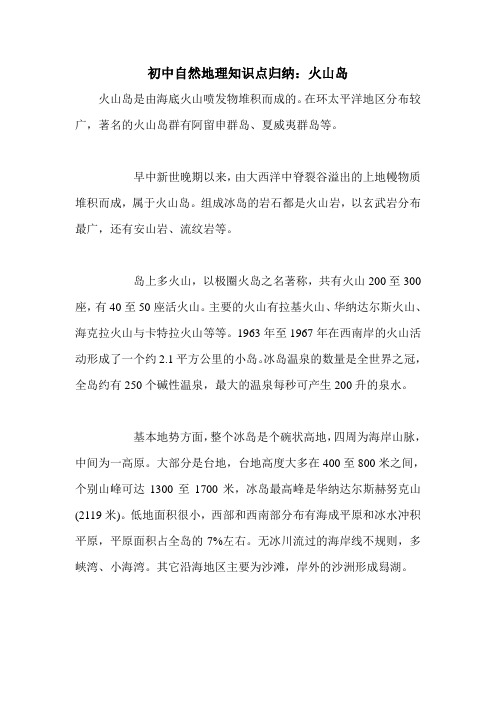
初中自然地理知识点归纳:火山岛
火山岛是由海底火山喷发物堆积而成的。
在环太平洋地区分布较广,著名的火山岛群有阿留申群岛、夏威夷群岛等。
早中新世晚期以来,由大西洋中脊裂谷溢出的上地幔物质堆积而成,属于火山岛。
组成冰岛的岩石都是火山岩,以玄武岩分布最广,还有安山岩、流纹岩等。
岛上多火山,以极圈火岛之名著称,共有火山200至300座,有40至50座活火山。
主要的火山有拉基火山、华纳达尔斯火山、海克拉火山与卡特拉火山等等。
1963年至1967年在西南岸的火山活动形成了一个约2.1平方公里的小岛。
冰岛温泉的数量是全世界之冠,全岛约有250个碱性温泉,最大的温泉每秒可产生200升的泉水。
基本地势方面,整个冰岛是个碗状高地,四周为海岸山脉,中间为一高原。
大部分是台地,台地高度大多在400至800米之间,个别山峰可达1300至1700米,冰岛最高峰是华纳达尔斯赫努克山(2119米)。
低地面积很小,西部和西南部分布有海成平原和冰水冲积平原,平原面积占全岛的7%左右。
无冰川流过的海岸线不规则,多峡湾、小海湾。
其它沿海地区主要为沙滩,岸外的沙洲形成舄湖。
阿留申群岛形成原因的原理

阿留申群岛形成原因的原理阿留申群岛是位于北太平洋的一个大型火山弧,由230多个火山岛组成,面积超过2.7万平方公里。
它的形成原因与构造板块运动和俯冲岩浆作用有关。
下面我将分几个方面详细阐述阿留申群岛形成的原理。
首先,阿留申群岛的形成与构造板块运动密切相关。
在地球上,地壳被分为七个大板块和一些小板块,它们以不断运动的方式相互碰撞、挤压和分离。
阿留申群岛位于“环太平洋火山带”上,这是地球上最活跃的火山带之一。
这个火山带是太平洋板块和美洲板块的交汇处,两个板块之间发生了俯冲作用,俯冲带上形成了许多火山。
其次,阿留申群岛形成的原理与俯冲岩浆作用有关。
俯冲带上,太平洋板块向下俯冲进入地幔,随着深度的增加,板块会在高温高压下开始融化。
融化的岩石称为岩浆,它比固体岩石更轻,会向上移动并聚集在地壳下方。
当岩浆积聚到一定程度时,它会在地壳中形成岩浆池,最终以火山喷发的形式喷出地表,形成了火山。
阿留申群岛的形成过程可以简单概括为以下几个阶段。
首先是火山岛的形成阶段。
当岩浆从地壳下上涌时,会在地壳下方形成岩浆池。
随着岩浆的不断积聚,地壳上方形成了一座隆起的火山岛。
这个岛屿一开始可能只是一个小的岩石堆积体,随着时间的推移,岩浆继续喷发,喷发物积聚在火山口周围,逐渐形成一个较大的火山岛。
其次是岛链的形成阶段。
当火山岛不断喷发岩浆时,新的火山岛陆续形成。
这些岛屿位于俯冲带的同一位置,因此在地壳上形成了一条岛链。
阿留申群岛就是这样的一个岛链,由不断喷发岩浆形成的火山岛组成。
最后是岛屿的演化阶段。
随着时间的推移和构造板块的运动,岛屿会经历一系列的演化过程。
首先,活跃的火山岛会慢慢冷却并停止喷发,形成休眠火山。
接着,火山岛会逐渐沉降并与周围的岛屿连成一体。
最后,岛屿会进一步沉降并侵蚀,形成海底山脉。
总结起来,阿留申群岛的形成主要是由于构造板块的运动和俯冲岩浆作用。
火山岛的形成是火山喷发物积聚的结果,岛链的形成是火山岛陆续形成的结果,岛屿的演化则是岛屿沉降和侵蚀的过程。
岛屿成因分类型及成因

岛屿成因分类型及成因
岛屿可以按照其形成的不同方式和成因进行分类。
以下是一些常见的岛屿成因类型:
1.火山岛(火山性岛屿):火山岛是由火山喷发或火山活动形成的。
这些岛屿通常是
由火山锥形成,例如夏威夷群岛就是火山岛的典型例子。
火山岛可以是由单个火山活动形成,也可以是由多个火山喷发形成的岛弧或岛链。
2.隆起岛:隆起岛形成于海底地壳隆起或隆升,可能是由地壳运动、地震或板块活动
引起的。
这种类型的岛屿可以是陆地延伸或大陆架的一部分,当板块抬升时形成陆地岛屿,例如印度洋的塞舌尔群岛。
3.珊瑚礁岛:珊瑚礁岛是由珊瑚虫群落建造的,通常形成在温暖浅海水域中。
当珊瑚
虫死亡并堆积在一起时,它们的遗骸形成了珊瑚礁。
这些礁可以在海水面以上形成岛屿,例如太平洋的很多岛屿,如马尔代夫。
4.冰川岛(冰碛岛):冰川岛是由冰川运动和作用形成的,当冰川融化时,它们可能
会携带着岩石和土壤,随着冰川退缩,这些沉积物可以形成岛屿。
这种类型的岛屿通常位于极地和高纬度地区。
5.人工岛:人工岛是人工建造的岛屿,通常是为了满足特定的人类需求,比如用于城
市发展、港口建设或度假胜地。
人工岛可以通过填海造陆、堆石块或其他建造技术建造而成。
这些不同类型的岛屿形成机制反映了地球不同地质和自然过程的作用,每种类型的岛屿都有其独特的成因和特征。
火山岛地形的变迁
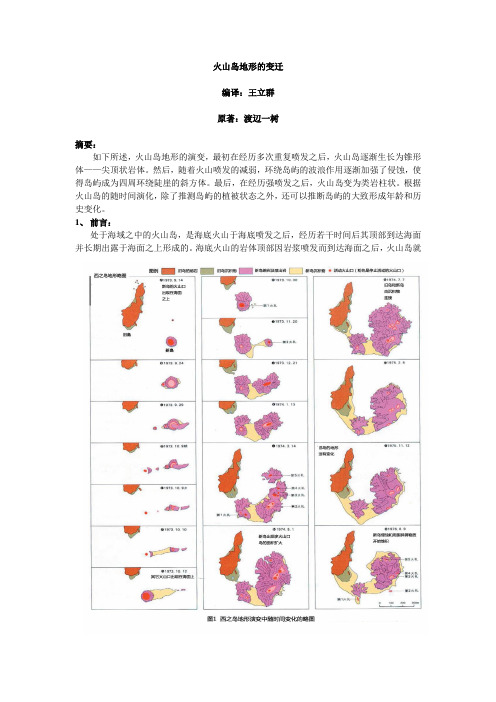
火山岛地形的变迁编译:王立群原著:渡辺一树摘要:如下所述,火山岛地形的演变,最初在经历多次重复喷发之后,火山岛逐渐生长为锥形体——尖顶状岩体。
然后,随着火山喷发的减弱,环绕岛屿的波浪作用逐渐加强了侵蚀,使得岛屿成为四周环绕陡崖的斜方体。
最后,在经历强喷发之后,火山岛变为类岩柱状。
根据火山岛的随时间演化,除了推测岛屿的植被状态之外,还可以推断岛屿的大致形成年龄和历史变化。
1、前言:处于海域之中的火山岛,是海底火山于海底喷发之后,经历若干时间后其顶部到达海面并长期出露于海面之上形成的。
海底火山的岩体顶部因岩浆喷发而到达海面之后,火山岛就接受海面波浪作用形成的侵蚀,火山岩体被侵蚀后的形状不同于内陆地区出现的由河流和泥石流侵蚀而形成的低洼地形。
在海面,如果火山喷发出的岩浆冷凝后形成的熔岩、火山岩体的数量大于波浪作用的侵蚀量,那么火山岩体就会长期出露于海面而形成岛屿,同时其周围受到波浪作用的侵蚀,在火山岛的边缘发育出海蚀涯。
在日本近海存在大量的海底火山,如西之岛新岛、明神礁、福德冈场之类。
从因火山爆发而处于诞生期的新岛屿到如伊豆大岛那样因长期喷发的结果形成的大火山岛并在其四周发育有海蚀涯的岛屿,火山岛的形状存在多样性。
东京大学名誉教授,小坂丈予先生从船上观察1952年明神礁的火山爆发情况(平林·野上,2012),从飞机上观察1973年西之岛火山喷发形成的新岛地形,保留下来西之岛新岛地形的详细资料(小坂,1978,图1)。
之后又进一步记录西之岛新岛的地形、海岸线的变化并报告了关于火山岛形成时的喷发样式及海蚀作用形成的地形变化(小坂,2004)。
本报告以小坂先生的经验为基础,主要以南方诸岛和南西诸岛为例,说明海底火山的顶部到达海面状态之后的火山喷发活动过程、被海蚀作用侵蚀的火山岛以及其周边浅水域地形的变迁。
2、火山岛的地形在南方诸岛、南西诸岛的火山岛研究中,存有航空观测到的近年喷发活动的详细资料,此外根据海上调查船的测量结果,明确了火山岛周边浅水域详细的海底地形。
岩浆活动形成的地貌

岩浆活动形成的地貌
岩浆活动可以形成各种各样的地貌特征,以下是几个常见的岩浆活动形成的地貌:
1. 火山:岩浆从地下喷发到地表,形成火山。
火山可能是圆锥形状的或者是扁平的,其形态取决于火山岩的粘度和喷发方式。
火山会在周围的地区堆积出大量的岩浆、火山灰和熔岩,形成火山锥、火山口和火山喷发口等特征。
2. 玄武岩台地:玄武岩是一种常见的喷发岩浆,其高温高粘度的特性使其在喷发时不容易流动到远离火山口的地方,因此在火山口周围会堆积成大量的熔岩,最终形成玄武岩台地。
玄武岩台地通常有平坦的表面和陡峭的边缘。
3. 火山口湖:当火山锥形成后,火山口可能会被降雨或地下水充满,形成火山口湖。
火山口湖在地球上很常见,如美国的克拉特湖和坎帕尼亚大区的卡西特拉火山口湖。
4. 火山岛:当岩浆从海底喷发到海面上时,可以形成火山岛。
如夏威夷群岛就是岩浆活动造成的火山岛链。
5. 玄武岩柱:当熔岩冷却并收缩时,可能会形成六边形的柱状结构,这就是玄武岩柱。
玄武岩柱在许多火山地区都可以见到,如爱尔兰的基尔凯尼火山和冰岛的巴尔纳火山。
6. 熔岩洞穴:熔岩穿过地下地层时,可能会形成长而窄的洞穴,这是熔岩洞穴。
熔岩洞穴在冰岛的戈贝洞穴和夏威夷的图爾特
洞穴都很有名。
这些是岩浆活动形成的一些常见地貌,具体地貌特征还有很多种类,取决于岩浆的类型、喷发方式和地质环境。
小学地理海岛知识点归纳

小学地理海岛知识点归纳海岛是指位于海洋中的较小的陆地,由于地球表面的70%是海洋,海岛在地理学中扮演着重要的角色。
在小学地理学科中,学生需要了解和掌握一些关于海岛的知识点。
本文将归纳总结一些和海岛相关的知识点,以帮助学生更好地学习和理解这一内容。
1. 什么是海岛?海岛是指位于海洋中的较小陆地。
它们通常由岛屿、岛礁或珊瑚岛等构成。
海岛与大陆相比,较为独立,并且其周围被海水所环绕。
2. 海岛的分类根据形成方式,海岛可以分为火山岛、碎屑岛和珊瑚岛。
- 火山岛:火山岛是由火山活动造成的。
岛屿通常是由火山喷口喷发的熔岩和火山碎屑堆积而成。
- 碎屑岛:碎屑岛由河流、湖泊、冰川等作用带来的沉积物积累而成。
通常是由河流与水流将碎屑物质冲积至海洋中形成的。
- 珊瑚岛:珊瑚岛是由珊瑚虫构成的。
珊瑚虫生长在温暖的海洋环境中,形成钙质骨架,并随着时间的推移逐渐积累形成岛屿。
3. 世界著名的海岛地球上有很多著名的海岛,其中一些是国际旅游胜地,受到了世界各地游客的喜爱。
- 巴厘岛(印度尼西亚):巴厘岛位于印度尼西亚的巴厘省,以其美丽的海滩和宜人的气候而闻名。
这里的旅游景点如水晶湾、库塔海滩等吸引了来自世界各地的游客。
- 马尔代夫:马尔代夫是由26个环礁和1,200多个珊瑚岛组成的国家。
这个度假胜地以其白色沙滩、蓝色海水和丰富的海洋生物而著名。
- 夏威夷(美国):夏威夷是美国的最后一个州,位于太平洋中部。
其著名的海滩、火山和冲浪文化吸引了全球的游客。
4. 海岛的地理特点海岛因其特殊的地理环境而具有一些独特的特点。
- 地理位置:海岛通常位于大陆架边缘或海洋中的板块边界。
它们往往是海洋地壳的一部分,与大陆之间由深海槽隔开。
- 地质构造:火山岛形成于板块构造点上,由火山喷发产生的火山岩积累而成。
而碎屑岛则是由河流或冰川冲刷、冲积而成的沉积物。
- 气候:海岛往往受到海洋环流的影响,气候相对较为温暖。
另外,由于受到海洋环境的影响,海岛上的降雨量通常较大,植被丰富。
海岛形成的原理

海岛形成的原理海岛是指由海床上升而形成的陆地小岛或大陆岛。
海岛的形成是一个复杂的过程,涉及到多种地质和地形过程。
以下是海岛形成的几个主要原理。
首先,火山活动是形成海岛的重要原理之一。
当地壳板块发生运动,地幔部分的熔岩可以通过地壳的裂缝冒出,形成火山喷发。
喷发的熔岩冷却凝固后,会逐渐积聚堆积形成海床,最终形成火山岛。
火山岛一般具有陡峭的形态,表面保存着火山喷发的特征,比如火山口、火山锥等。
其次,地壳板块碰撞也是海岛形成的原理之一。
当两块地壳板块相互碰撞,其中一块陆地板块沉入地幔中,而另一块海底板块上升形成山岳。
随着时间的推移,山岳逐渐冲刷削减,最终形成海岛。
碰撞型海岛通常有较为平缓的山体,海岛附近可能有形状各异的海岬、半岛等地形。
此外,沉积作用也是海岛形成的原理之一。
当大量的沉积物被河流或海浪带到海岸线附近,随着时间的推移,沉积物堆积积聚形成沉积岛。
这种形成方式通常发生在河口、河流和海洋交汇处。
沉积型海岛具有平坦的地形,周围可能有广阔的河口和滩涂。
另外,风化和侵蚀也是影响海岛形成的重要因素。
风化和侵蚀过程中,水和风对海岛进行冲刷和削减,造成地壳的塌陷和海床的上升,从而形成相对较低的陆地。
这种形成方式主要发生在暴露在风浪和水流之中的岛屿,比如海岸线附近的珊瑚岛屿。
此外,地质构造的演化也对海岛形成起到了重要影响。
地质构造是指地球地壳和地幔的形成和演变过程。
不同地区的地质构造不同,地壳板块的运动和形变对海岛的形成和变化具有很大影响。
地质构造的变化可能导致陆地的隆起或沉降,从而形成或改变海岛的形态。
综上所述,海岛的形成是多种地质和地形过程相互作用的结果。
火山活动、地壳板块碰撞、沉积作用、风化侵蚀以及地质构造演化都是海岛形成的重要原理。
这些过程的相互作用使得地壳表面发生变化,最终形成了我们眼中的美丽海岛。
大陆岛、火山岛、珊瑚岛-初中地理知识
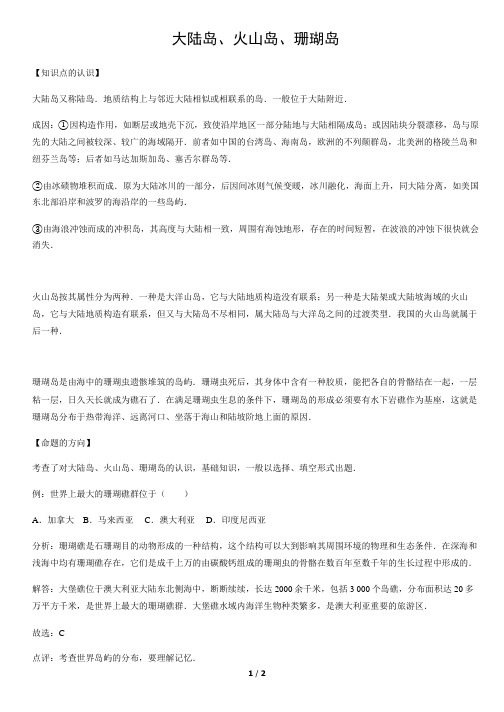
大陆岛、火山岛、珊瑚岛【知识点的认识】大陆岛又称陆岛.地质结构上与邻近大陆相似或相联系的岛.一般位于大陆附近.成因:①因构造作用,如断层或地壳下沉,致使沿岸地区一部分陆地与大陆相隔成岛;或因陆块分裂漂移,岛与原先的大陆之间被较深、较广的海域隔开.前者如中国的台湾岛、海南岛,欧洲的不列颠群岛,北美洲的格陵兰岛和纽芬兰岛等;后者如马达加斯加岛、塞舌尔群岛等.②由冰碛物堆积而成.原为大陆冰川的一部分,后因间冰则气候变暖,冰川融化,海面上升,同大陆分离,如美国东北部沿岸和波罗的海沿岸的一些岛屿.③由海浪冲蚀而成的冲积岛,其高度与大陆相一致,周围有海蚀地形,存在的时间短暂,在波浪的冲蚀下很快就会消失.火山岛按其属性分为两种.一种是大洋山岛,它与大陆地质构造没有联系;另一种是大陆架或大陆坡海域的火山岛,它与大陆地质构造有联系,但又与大陆岛不尽相同,属大陆岛与大洋岛之间的过渡类型.我国的火山岛就属于后一种.珊瑚岛是由海中的珊瑚虫遗骸堆筑的岛屿.珊瑚虫死后,其身体中含有一种胶质,能把各自的骨骼结在一起,一层粘一层,日久天长就成为礁石了.在满足珊瑚虫生息的条件下,珊瑚岛的形成必须要有水下岩礁作为基座,这就是珊瑚岛分布于热带海洋、远离河口、坐落于海山和陆坡阶地上面的原因.【命题的方向】考查了对大陆岛、火山岛、珊瑚岛的认识,基础知识,一般以选择、填空形式出题.例:世界上最大的珊瑚礁群位于()A.加拿大B.马来西亚C.澳大利亚D.印度尼西亚分析:珊瑚礁是石珊瑚目的动物形成的一种结构,这个结构可以大到影响其周围环境的物理和生态条件.在深海和浅海中均有珊瑚礁存在,它们是成千上万的由碳酸钙组成的珊瑚虫的骨骼在数百年至数千年的生长过程中形成的.解答:大堡礁位于澳大利亚大陆东北侧海中,断断续续,长达 2000 余千米,包括 3 000 个岛礁,分布面积达 20 多万平方千米,是世界上最大的珊瑚礁群.大堡礁水域内海洋生物种类繁多,是澳大利亚重要的旅游区.故选:C点评:考查世界岛屿的分布,要理解记忆.【解题思路点拔】主要考查了对大陆岛、火山岛、珊瑚岛的认识,熟记概念以及各自特征、分布区.。
火山岛——百慕大群岛
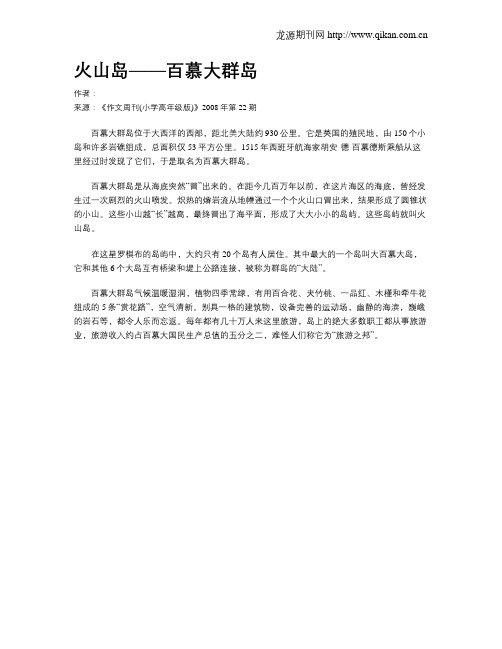
龙源期刊网
火山岛——百慕大群岛
作者:
来源:《作文周刊(小学高年级版)》2008年第22期
百慕大群岛位于大西洋的西部,距北美大陆约930公里。
它是英国的殖民地,由150个小岛和许多岩礁组成,总面积仅53平方公里。
1515年西班牙航海家胡安·德·百慕德斯乘船从这里经过时发现了它们,于是取名为百慕大群岛。
百慕大群岛是从海底突然“冒”出来的。
在距今几百万年以前,在这片海区的海底,曾经发生过一次剧烈的火山喷发。
炽热的熔岩流从地幔通过一个个火山口冒出来,结果形成了圆锥状的小山。
这些小山越“长”越高,最终冒出了海平面,形成了大大小小的岛屿。
这些岛屿就叫火山岛。
在这星罗棋布的岛屿中,大约只有20个岛有人居住。
其中最大的一个岛叫大百慕大岛,它和其他6个大岛互有桥梁和堤上公路连接,被称为群岛的“大陆”。
百慕大群岛气候温暖湿润,植物四季常绿,有用百合花、夹竹桃、一品红、木槿和牵牛花组成的5条“赏花路”,空气清新。
别具一格的建筑物,设备完善的运动场,幽静的海滨,巍峨的岩石等,都令人乐而忘返。
每年都有几十万人来这里旅游,岛上的绝大多数职工都从事旅游业,旅游收入约占百慕大国民生产总值的五分之二,难怪人们称它为“旅游之邦”。
了解地球上的岛屿地理和岛屿环境

了解地球上的岛屿地理和岛屿环境地球上的岛屿分布广泛,它们通常被海水所包围,具有独特的地理特征和生态环境。
岛屿地理与岛屿环境密切相关,对于理解地球的自然与人文景观都有重要意义。
本文将从岛屿地理、岛屿形成和岛屿生态环境等方面探讨了解地球上的岛屿的内容。
一、岛屿地理1.1 岛屿的定义岛屿是被海水或其他水体所包围的陆地,它可以是由火山活动造成的火山岛,也可以是在陆地断裂或海陆交汇处形成的大陆岛。
岛屿的面积从几十平方米到几百万平方公里不等。
1.2 岛屿分布地球上的岛屿分布广泛,主要集中在太平洋、大西洋和印度洋等海洋中。
其中,太平洋是世界上最大的岛屿集中地,包括许多著名的岛屿国家和地区,如印度尼西亚、菲律宾、日本和夏威夷等。
1.3 岛屿类型岛屿的类型多种多样,可以根据岛屿的形成方式进行分类。
火山岛是由火山活动喷发而成的,如夏威夷群岛;隆起岛是由地壳运动隆起而成的,如塞舌尔群岛;珊瑚岛是由珊瑚虫类的生长堆积形成的,如马尔代夫等。
二、岛屿形成2.1 火山活动火山活动是岛屿形成的重要原因之一。
当地壳板块运动引起岩浆上升到地表时,由于岩浆的喷发和堆积,形成了火山岛。
火山岛通常具有陡峭的山脉和丰富的火山岩石资源。
2.2 地壳运动地壳运动是岛屿形成的另一个重要原因。
当地壳板块发生断裂或抬升时,原本的陆地就会被水体所包围,形成大陆岛。
这种类型的岛屿通常与周边陆地相连,并与大陆板块上的地理环境相似。
2.3 生物作用生物作用也对岛屿的形成起到了一定影响。
例如,珊瑚虫类在热带海域广泛生长,并通过它们的死亡和骨骼堆积形成了珊瑚岛。
此外,植物和动物的迁移也会导致种子的传播和生态系统的建立,从而形成具有特殊生态环境的岛屿。
三、岛屿生态环境3.1 植被岛屿上的植被通常具有特殊的适应性和多样性。
岛屿地理的隔离性和特殊的气候条件使得一些特定类型的植物在岛屿上独特地繁衍生长。
例如,马达加斯加岛被称为“自然的迷宫”,拥有丰富多样的植物资源。
3.2 动物岛屿上的动物种类也与其地理位置密切相关。
岛屿的分类

澳大利亚大堡礁
(3)火山岛:火山岛是由海底火山喷发物堆积 而成的。在环太平洋地区分布较广,著名的火山 岛群有阿留申群岛、夏威夷群岛等。
火山岛成因图
ห้องสมุดไป่ตู้ 夏威夷群岛
(4)冲积岛:冲积岛是陆地的河流夹带泥沙搬 运到海里,沉积下来形成的海上陆地。陆地的河 流流速比较急,带着上游冲刷下来的泥沙流到宽 阔的海洋后,流速就慢了下来,泥沙就沉积在河 口附近,积年累月,越积越多,逐步形成高出水 面的陆地,这就叫冲积岛。如我国的崇明岛和很 多河流的沙洲。
一、世界上的岛屿按照成因分类 (1)大陆岛 (2)珊瑚岛
岛屿的分 类 (3)火山岛 (4)冲积岛
(1)大陆岛:因构造作用,如断层或地壳下沉, 致使沿岸地区一部分陆地与大陆相隔成岛;或因 陆块分裂漂移,岛与原先的大陆之间被较深、较 广的海域隔开。前者如中国的海南岛、台湾岛、 北美洲的格陵兰岛等;后者如非洲的马达加斯加 岛等。
问答环节: 同学们,经过我们的学习你现在能义 正言辞的说出课件开头问题的答案了么?
答案:钓鱼岛及其附属岛屿是台湾北部近海 的观音山、大屯山等海岸山脉延伸入海后的 突出部分,是典型的大陆岛,因此,依照 1960年生效的大陆架公约观点,钓鱼台列岛 理应为台湾岛的一部分。
宝岛台湾
马 达 加 斯 加 岛
(2)珊瑚岛:珊瑚岛是由海中的珊瑚虫遗骸堆 筑的岛屿。珊瑚虫死后,其身体中含有一种胶质, 能把各自的骨骼结在一起,一层粘一层,日久天 长就成为礁石了,根据它形成的形态可以分为岸 礁、堡礁和环礁三种类型。
小贴士:珊瑚虫的生长环境要求较高,一般需要温度 较高、水质良好并且阳光充足的浅海区才能生存。
关于海岛的资料

关于海岛的资料
海岛是指位于海洋上的小块陆地,与大陆相隔较远,被海水环绕,通常由珊瑚、火山、碎屑等形成。
以下是一些关于海岛的资料:
1. 分类:根据形成方式可分为珊瑚岛、火山岛和大陆岛。
珊瑚岛是由珊瑚虫的骨骼堆积形成,火山岛是由火山喷发形成,大陆岛则是原本与大陆相连的陆地,由海水淹没后形成的海岛。
2. 分布:全球范围内有许多海岛,主要集中在太平洋、印度洋和大西洋等大洋中。
著名的海岛包括巴厘岛、夏威夷群岛、马尔代夫、希腊的圣托里尼岛等。
3. 特征:海岛通常面积较小,地理环境多样,包括沙滩、海岸线、海洋生物和珊瑚礁等。
许多海岛是旅游胜地,拥有美丽的景观、海滩度假胜地和丰富的海洋生物资源。
4. 生态系统:海岛生态系统独特而脆弱,包括珊瑚礁、滩涂和热带雨林等。
许多海岛上的动植物是特有的,受到环境变化和人类活动的威胁。
5. 人类活动:海岛上的居民主要从事渔业、农业和旅游业。
许多海岛是旅游热点,吸引着大量的游客前来观光。
然而,过度的人类活动和气候变化带来的海平面上升等问题对海岛的可持续发展造成了一定的威胁。
总之,海岛是地球上独特而美丽的一部分,不仅拥有丰富的自
然资源和生态系统,也是文化和旅游的重要场所。
然而,保护好海岛的生态环境,才能让这些美丽的地方长久地存在,并为人们带来福祉。
火山岛是如何形成的?
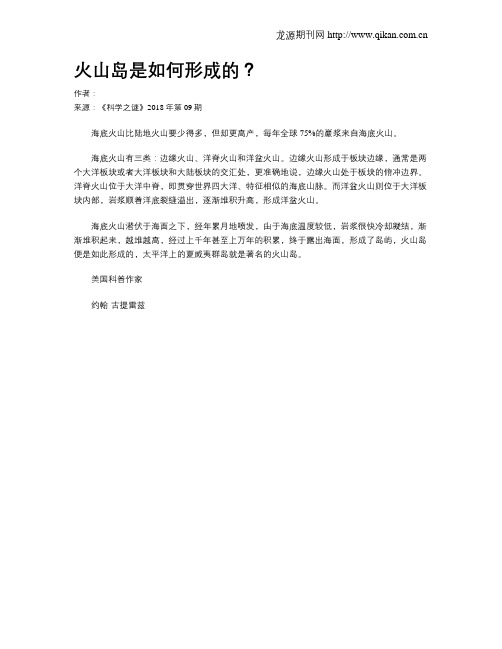
龙源期刊网
火山岛是如何形成的?
作者:
来源:《科学之谜》2018年第09期
海底火山比陆地火山要少得多,但却更高产,每年全球75%的巖浆来自海底火山。
海底火山有三类:边缘火山、洋脊火山和洋盆火山。
边缘火山形成于板块边缘,通常是两个大洋板块或者大洋板块和大陆板块的交汇处,更准确地说,边缘火山处于板块的俯冲边界。
洋脊火山位于大洋中脊,即贯穿世界四大洋、特征相似的海底山脉。
而洋盆火山则位于大洋板块内部,岩浆顺着洋底裂缝溢出,逐渐堆积升高,形成洋盆火山。
海底火山潜伏于海面之下,经年累月地喷发,由于海底温度较低,岩浆很快冷却凝结,渐渐堆积起来,越堆越高,经过上千年甚至上万年的积累,终于露出海面,形成了岛屿,火山岛便是如此形成的,太平洋上的夏威夷群岛就是著名的火山岛。
美国科普作家
约翰·古提雷兹。
海南火山岩
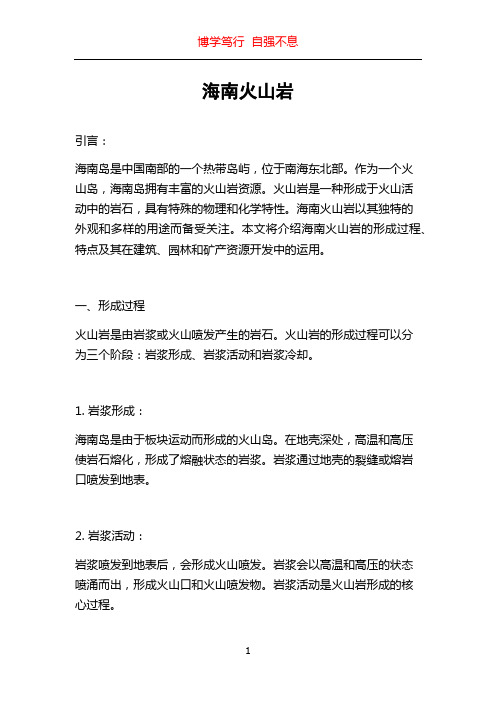
海南火山岩引言:海南岛是中国南部的一个热带岛屿,位于南海东北部。
作为一个火山岛,海南岛拥有丰富的火山岩资源。
火山岩是一种形成于火山活动中的岩石,具有特殊的物理和化学特性。
海南火山岩以其独特的外观和多样的用途而备受关注。
本文将介绍海南火山岩的形成过程、特点及其在建筑、园林和矿产资源开发中的运用。
一、形成过程火山岩是由岩浆或火山喷发产生的岩石。
火山岩的形成过程可以分为三个阶段:岩浆形成、岩浆活动和岩浆冷却。
1. 岩浆形成:海南岛是由于板块运动而形成的火山岛。
在地壳深处,高温和高压使岩石熔化,形成了熔融状态的岩浆。
岩浆通过地壳的裂缝或熔岩口喷发到地表。
2. 岩浆活动:岩浆喷发到地表后,会形成火山喷发。
岩浆会以高温和高压的状态喷涌而出,形成火山口和火山喷发物。
岩浆活动是火山岩形成的核心过程。
3. 岩浆冷却:岩浆冷却是指岩浆由于环境温度而逐渐冷却并凝固成固态岩石的过程。
在冷却过程中,火山岩产生了独特的结晶和斑点。
二、特点海南火山岩具有一些独特的特点,使得它成为建筑和园林设计中的理想选择。
1. 外观美观:火山岩的表面通常呈现出灰色、黑色或红色等鲜明的颜色。
它具有丰富的纹理和石纹,使得海南火山岩成为一种美观的建筑材料。
2. 耐久性及硬度:海南火山岩具有良好的耐久性和硬度,能够承受恶劣的天气和环境条件。
这使得它成为一种理想的室外材料。
3. 隔热性:火山岩具有良好的隔热性能,能够减少建筑物的热传导,提高建筑物的能源效率。
4. 可塑性:火山岩具有一定的可塑性,可以通过切割、打磨和雕刻等方式进行造型和设计。
这使得它广泛应用于园林设计中的雕塑、花坛、喷泉等。
三、应用领域1. 建筑领域:海南火山岩常用于建筑外墙、地面铺装、屋顶覆盖和室内装饰等。
它的美观性和耐久性使得它成为一种受欢迎的建筑材料。
2. 园林设计:火山岩在园林设计中有广泛的应用。
它可以用于园林景观的铺地、护坡、假山、景墙等。
火山岩不仅具有美观的外观,还可以表现出独特的造型效果,使得园林景观更加生动。
中国地质最年轻的火山岛

中国地质最年轻的火山岛中国拥有着丰富的自然景观和地质资源,其中著名的火山岛居然还有来自中国。
而中国地质最年轻的火山岛是指海南省东南沿海的一个小岛,即海南岛东北部的雷州半岛。
海南岛作为中国最大的热带岛屿,拥有着丰富的旅游资源和自然景观。
而雷州半岛作为海南岛的一部分,位于海南岛的东北方向,是中国地质最年轻的火山岛。
雷州半岛地处于环南海地区,地质构造活动频繁,因此出现了许多火山岛。
雷州半岛的火山岛始于约3000万年前的新近纪时期,至今已有数百万年的历史。
这个火山岛的形成主要与地壳板块的运动和构造变动有关。
尤其是板块碰撞和熔融岩浆的活动,为雷州半岛火山岛的形成提供了一个理想的地质环境。
火山岛的形成一般分为喷发期、休眠期和侵蚀期三个阶段。
在喷发期,地壳板块的运动和地底岩浆的冲击力造成了火山岛的喷发活动,熔岩和火山碎屑堆积形成一个个的火山喷发口。
随着喷发活动的结束,火山岛进入休眠期,此时熔岩流冷却凝固,形成了具有典型火山构造的岩石地层。
在侵蚀期,水流、风蚀等自然力量使火山岛逐渐剥蚀,形成了岩石崖壁、海蚀平台等地貌。
雷州半岛的火山岛地质特征非常丰富多样。
首先,火山岛周围是一片大片的海岸平原,这是因为火山岛的喷发活动时,在熔岩流下方的海底沉积物不断被再次淹没覆盖而形成。
其次,火山岛上的岩石层非常复杂,主要由玄武岩、安山岩、流纹岩等构成。
这些火山岩具有坚硬耐磨的特点,被广泛应用于建筑和道路等领域。
最后,火山岛周围是一片湿地和海蚀平台,这些自然景观为生态保护提供了良好的基础。
由于地质的年轻和多样性,雷州半岛的火山岛成为了一个独特的地质遗迹和自然景观。
这片火山岛不仅吸引了地质学家和学者的关注,也吸引着众多游客和旅行者前来观光和旅游。
人们可以通过海上游船,近距离地观察这些火山岛的地貌特征和自然景观,领略大自然的鬼斧神工。
此外,雷州半岛的火山岛还是一个重要的地质研究基地。
科学家们通过对火山岛的研究,可以更好地了解地壳板块运动和熔岩岩浆柱活动的机制和规律,为地质灾害的预防和预测提供更可靠的依据。
《海陆变迁》火山岛诞生记
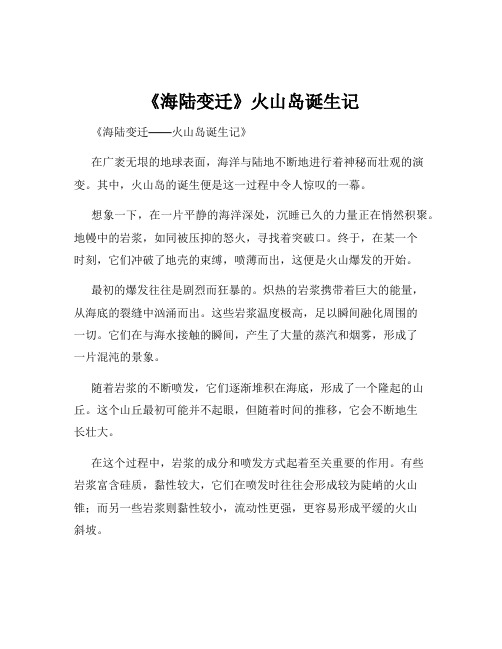
《海陆变迁》火山岛诞生记《海陆变迁——火山岛诞生记》在广袤无垠的地球表面,海洋与陆地不断地进行着神秘而壮观的演变。
其中,火山岛的诞生便是这一过程中令人惊叹的一幕。
想象一下,在一片平静的海洋深处,沉睡已久的力量正在悄然积聚。
地幔中的岩浆,如同被压抑的怒火,寻找着突破口。
终于,在某一个时刻,它们冲破了地壳的束缚,喷薄而出,这便是火山爆发的开始。
最初的爆发往往是剧烈而狂暴的。
炽热的岩浆携带着巨大的能量,从海底的裂缝中汹涌而出。
这些岩浆温度极高,足以瞬间融化周围的一切。
它们在与海水接触的瞬间,产生了大量的蒸汽和烟雾,形成了一片混沌的景象。
随着岩浆的不断喷发,它们逐渐堆积在海底,形成了一个隆起的山丘。
这个山丘最初可能并不起眼,但随着时间的推移,它会不断地生长壮大。
在这个过程中,岩浆的成分和喷发方式起着至关重要的作用。
有些岩浆富含硅质,黏性较大,它们在喷发时往往会形成较为陡峭的火山锥;而另一些岩浆则黏性较小,流动性更强,更容易形成平缓的火山斜坡。
火山岛的形成并非一蹴而就,而是经历了漫长的岁月。
在火山喷发的间歇期,海水会侵蚀刚刚形成的火山地貌。
海浪不断地冲击着火山的边缘,带走松散的岩石和碎屑,使得火山岛的轮廓逐渐变得清晰。
同时,火山活动还会带来一系列的地质变化。
地震、断层等现象时有发生,它们进一步塑造着火山岛的形态。
而火山喷发所产生的火山灰和碎屑物质,在周围海域沉积下来,形成了肥沃的土壤,为日后生命的繁衍创造了条件。
当火山岛逐渐露出海面,它便成为了海洋中的一片新大陆。
然而,这仅仅是一个开始。
新生的火山岛往往是一片荒芜的景象,没有植被,没有动物,只有裸露的岩石和贫瘠的土壤。
但生命的力量是无穷的。
随着时间的推移,一些植物的种子可能会被风吹到岛上,或者随着海水漂流而来。
这些顽强的生命在这片看似不毛之地上生根发芽,逐渐形成了稀疏的植被。
鸟类也会被这片新的陆地所吸引。
它们在这里停歇、觅食,留下了粪便和未消化的种子,进一步促进了植物的生长和繁衍。
岛屿地质与地貌演化

岛屿地质与地貌演化岛屿是大海中的一块陆地,围绕着大海,环境独特,风光迷人。
岛屿的地质和地貌特征因其独特的地理位置和形成过程而各具特点。
在岛屿地质与地貌演化的历史长河中,每一个岛屿都有着它独特的故事。
一、地质形成岛屿地质形成是一个长期的过程。
大多数岛屿是由海底火山喷发形成的,也有一部分是由陆地上升或者地壳运动形成的。
无论是哪种形成方式,都离不开地质的作用。
海底火山是岛屿形成的主要原因之一。
在板块运动的过程中,地壳会发生破裂和运动,从而导致地下熔岩喷发,形成新的火山岛屿。
这些火山岛屿随着时间的推移,陆续冷却凝固,最终形成稳定的岛屿地质结构。
另外,陆地的上升也是岛屿形成的原因之一。
在地壳运动的过程中,部分陆地会上升,形成新的地理结构,从而形成新的岛屿。
这种情况在一些海域中比较常见,比如印度尼西亚等地区。
二、地貌特征岛屿的地貌特征是由地质演化的结果所决定的。
不同地质结构会呈现出不同的地貌特征,比如火山岛屿和陆地上升岛屿的地貌特征就有所不同。
火山岛屿地貌特征多为陡峭山脉和深邃海岸线。
火山岛屿多是由火山喷发形成的,所以地层比较松散,容易形成陡峭的山峰和深邃的海底。
这种地貌特征在夏威夷等火山岛屿比较典型。
而陆地上升岛屿地貌特征多为平坦海域和浅滩海岸线。
陆地上升岛屿多是由陆地的上升形成的,地层比较坚硬,不容易侵蚀,所以地貌特征比较平坦和浅滩。
这种地貌特征在日本的一些岛屿中比较明显。
总的来说,岛屿地质与地貌演化是一个漫长而又神秘的过程。
每一个岛屿都有着它独特的故事,让人们感叹大自然的神奇和伟大。
希望人类能够尊重自然,保护岛屿,共同分享自然的纯净与美丽。
海底火山爆发形成海岛的科学原理

海底火山爆发形成海岛的科学原理海底火山爆发形成海岛的科学原理我们都知道海底火山爆发有很多的好处与坏处,但是海底火山爆发形成海岛是很多人不知道的事情。
下面是店铺为你精心推荐的海底火山爆发形成海岛原理,希望对您有所帮助。
海底火山爆发形成海岛科学原理最初,海底火山隐没于水下,一般面积不大,坡度较陡。
经过不断喷发,火山喷发出的熔岩逐渐向上堆积,形成了水下的山丘、石柱。
经过几千年甚至几十万年,喷发物越积越多,越堆越高,隐藏于水下的海山终于露出海面,形成了岛屿,这就是火山岛。
太平洋的夏威夷群岛就是长期以来火山喷发堆积而成的。
今天,位于夏威夷群岛的摩罗基尼坑火山口是一个新月形的海岛,深受潜水爱好者和海鸟的喜欢。
这里过去曾是一个圆圆的火山口,千百年来,它不断喷发,终于形成了许多新的岛屿。
当然,并不是所有的火山爆发都会形成海岛,火山岛一经形成也不是一成不变的。
当熔岩喷出海面形成火山岛以后,有时巨大的海浪会很快将新形成的火山岛冲散,使之再次沉没于海面之下,成为短命的火山岛。
1986年1月18日在日本小笠原群岛新增的一个火山岛,在当年的3月8日就消失了。
火山爆发形成原理1.海平面变化可能导致火山爆发炽热的岩浆在地下运行,遇到合适的机会就喷涌而出,形成火山爆发。
到底是什么因素“扣动”了火山的“扳机”呢?英国剑桥大学的一个地质学研究小组最近提出,海平面变化可能是导致火山爆发的原因之一。
过去,科学家一直试图从地震和潮汐的变化等现象寻找火山爆发的原因。
剑桥大学的研究为解释这一现象提供了新的方向,有关成果发表在最新一期的美国《地球物理研究通报》上。
过去300年全球火山爆发的统计记录显示,在北半球冬季月份里,全球火山爆发的可能性增加了18%。
泛太平洋地区这一现象尤为显著,在这几个月份里有些地方火山爆发的频率比平均值甚至高出50%。
剑桥大学的地质学研究小组认为,由于北半球的陆地面积大于南半球,这里冬季的积雪量大大高于南半球在冬季的积雪量。
- 1、下载文档前请自行甄别文档内容的完整性,平台不提供额外的编辑、内容补充、找答案等附加服务。
- 2、"仅部分预览"的文档,不可在线预览部分如存在完整性等问题,可反馈申请退款(可完整预览的文档不适用该条件!)。
- 3、如文档侵犯您的权益,请联系客服反馈,我们会尽快为您处理(人工客服工作时间:9:00-18:30)。
The birth of a volcanic island is an event marked by prolonged and violent travail:the forces of the earth striving to create, and all the forces of the sea opposing. At the place where the formation of such an island begins, the sea floor is probably nowhere more than about fifty miles thick. In it are deep cracks and fissures, the results of unequal cooling and shrinkage in past ages. Along such lines of weakness the molten lava fromthe earth's interior presses up and finally bursts forth into the sea.But a submarine volcano is different from a terrestrial eruption,where the lava, molten rocks, and gases are hurled into the air from an open crater. Here on the bottom of the ocean the volcano has resisting it all the weight of the ocean water above it. Despite the immense pressure of, it may be, two or three miles of sea water, the new volcanic cone builds upwards towards the surface, in flow after flow of lava. Once within reach of the waves, its soft ash is violently attacked by the motion of the water which continuallywashes away its upper surface, so that for a long period the potential island may remain submerged. But eventually, in new eruptions, the cone is pushed up into the air, where the lava hardens and forms a rampart against the attacks of the waves.
Volcanic Islands
Islands have always fascinated the human mind. Perhaps it is the instinctive response of man, the land animal, welcoming a brief intrusion of earth in the vast, overwhelming expanse of sea. When sailing in a great ocean basin, a thousand miles from the nearest continent, with miles of water beneath the ship,one may come upon an island which has been formed by a volcanic eruption under the sea. One's imagination can follow its slopes down through darkening waters to its base on the sea floor. One wond the midst of the ocean.
Hall, E. T. (1966). The hidden dimension. New York: Anchor.
1934/5000
火山群岛
群岛一直着迷于人类的思想。也许这就是人类的本能反应,即地球动物,在广袤浩瀚的大海中,迎来了地球的短暂侵入。当航行在距离最近的大陆千里之外的大洋流域时,可能会遇到一个由海下火山爆发形成的岛屿。一个人的想象力可以沿着它的斜坡通过黑暗的水域到海底的基地。人们想知道为什么以及如何在海洋中出现。
Hall,E. T.(1966)。隐藏的维度。纽约:锚。
As Koji Suzuki proposed in Global Implications of Patent Law Variation , each country has its own laws designed to protect domestic inventions and safeguard technology. Patent laws generally fall under one of two principles: the first-to-file and first-to-invent. A result of countries employing different patent law principles is inconsistency of patent ownership. Patent ownership is not recognized globally. This unclear ownership often has economic consequences. Many foreign individuals and companies believe that they are at a serious disadvantage in the United States with regard to patent ownership . Further, failure of the United States to recognize patent ownership in other countries is in violation of the Paris Conventions on Industrial Properties, which requires all member nations to treat all patents equally. WIPO maintains that the first necessary step involves compelling the United States to reexamine its patent principle, taking into account the reality of a global economy. This push may indeed result in more global economic cooperation.
